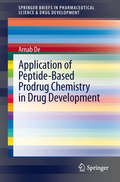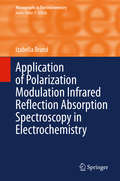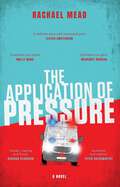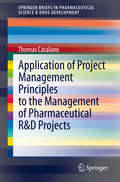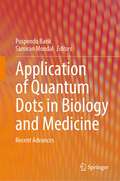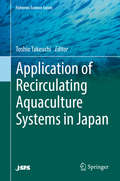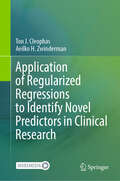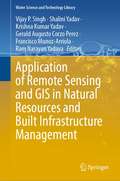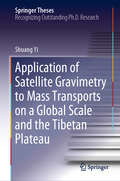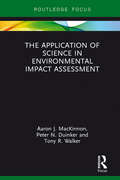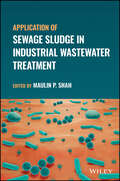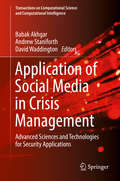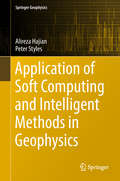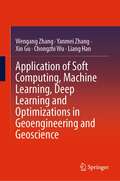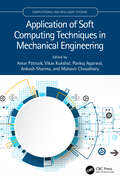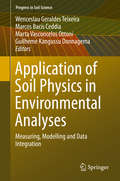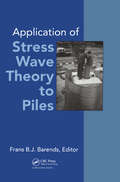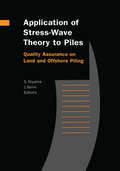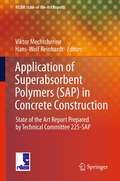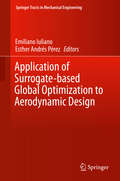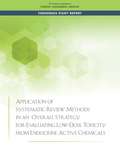- Table View
- List View
Application of Peptide-Based Prodrug Chemistry in Drug Development (SpringerBriefs in Pharmaceutical Science & Drug Development)
by Arnab DeMacromolecular (specifically peptide-based) drugs could potentially be highly effective medicines. However they have a relatively short duration of action and variable therapeutic index. An example of such a peptide is Glucagon-like Peptide I which could potentially be used as a revolutionary drug for diabetes. This is because it stimulates insulin only when the blood glucose level is high thereby reducing the risk of hypoglycemia (a significant disadvantage of using insulin is that an insulin overdose is the single most potent cause of life-threatening hypoglycemia). However it's short duration of action (half-life of 2 minutes in plasma) precludes its therapeutic use. In this volume, the use of novel therapeutics like GLP1 as an alternative to tradition insulin-based drugs in diabetes is described. Application of Peptide-Based Prodrug Chemistry in Drug Development elucidates the traditional concept of prodrugs as "specialized non-toxic protective groups used in a transient manner to alter or to eliminate certain limiting properties in the parent small molecule" (IUPAC definition). It goes on to provide insight into how prodrugs of peptides (with GLP1 as an example) could be appropriately used to extend the biological half life, broaden the therapeutic index of macromolecules and improve the pharmacodynamics of such drugs. Author explains the logic behind designing peptide prodrugs, synthetic procedures and bioassays to examine the conversion of the prodrug to the drug under therapeutic conditions. The prodrugs described slowly convert to the parent drug at physiological conditions of 37C and pH 7.2 driven by their inherent chemical instability without the need of any enzymatic cleavage. The diketopiperazine and diketomorpholine (DKP and DMP) strategies for prodrug conversion are demonstrated in detail with special emphasis on the chemical flexibility that it offers to develop prodrugs with variable time actions. This book will be of useful to chemists, biochemists, medicinal chemists, biologists and people in the medical profession (doctors). It may be used in undergraduate classes but will certainly help post-graduate students and advanced professionals. The author is grateful to Prof. Richard DiMarchi (Standiford H. Cox Professor of Chemistry and the Linda & Jack Gill Chair in Biomolecular Sciences at Indiana University) for valuable suggestions. The foreword for the book has been written by Prof. Jean Martinez, (Legion d'Honneur awarded by the French Republic; Professor of Chemistry and Medicinal Chemistry of the University of Montpellier, France; and Chairman of European Peptide Society, 2002-2010).
Application of Polarization Modulation Infrared Reflection Absorption Spectroscopy in Electrochemistry (Monographs in Electrochemistry)
by Izabella BrandThis book describes the physical basis of polarization modulation infrared reflection-absorption spectroscopy and its application in electrochemical studies. It provides a concise yet comprehensive review of the research done in this field in the last 20 years. Electrochemical methods are used to determine the rate and mechanism of charge transfer reactions between an electrode and species adsorbed or diffusing to its surface. In the past two decades PM-IRRAS has grown to be one of the most important vibrational spectroscopy techniques applied to investigate structural changes taking place at the electrochemical interface. The monograph presents foundations of this technique and reviews in situ studies of redox-inactive and redox-active films adsorbed on electrode surfaces. It also discusses experimental conditions required in electrochemical and spectroscopic studies and presents practical solutions to perform efficient experiments. As such, it offers an invaluable resource for graduate and postgraduate students, as well as for all researchers in academic and industrial laboratories.
Application of Pressure
by Rachael MeadTash and Joel are career paramedics, coming to the rescue of Adelaide residents of every class, culture and age. In a job where every day can bring death and violence, they maintain their sanity through a friendship built on black humour. But as the daily exposure to trauma begins to take its toll, both, in different ways, must fight to preserve their mental health and relationships - even with one another. How much pressure can Tash and Joel handle, and what happens when they finally crack? With each chapter revolving around an emergency - some frightening, some moving, some simply funny - The Application of Pressure is as tense as it is engaging. Digging beneath the shocking surface of gore and grit, Rachael Mead lays bare the humanity of emergency services personnel and their patients. Masterfully written, The Application of Pressure is a breathtaking and deeply human debut novel that reveals not only the trauma of a life lived on the frontline of medicine, but also the essential, binding friendships that make such a life possible.
Application of Project Management Principles to the Management of Pharmaceutical R&D Projects (SpringerBriefs in Pharmaceutical Science & Drug Development)
by Thomas CatalanoDr. Catalano has for the last ten years been doing consulting for the Pharmaceutical Industry. During his consulting he discovered that small businesses such as, generic, startups, and virtual companies do not have the budget or the resources to apply the computer software utilized in project management and therefore do not apply project management principles in their business model. This reduces their effectiveness and increases their operating cost. Application of Project Management Principles to the Management of Pharmaceutical R&D Projects is presented as a paper-based system for completing all the critical activities needed apply the project management system. This will allow these small business to take advantage of the project management principles and gain all the advantages of the system. This book will be beneficial for beginners to understand the concepts of project management and for small pharmaceutical companies to apply the principles of project management to their business model.
Application of Quantum Dots in Biology and Medicine: Recent Advances
by Puspendu Barik Samiran MondalThis book illustrates various applications of quantum dots (QDs) in the biomedical field and future perspectives. It first introduces the synthesis procedures and fundamental properties of QDs. In addition, the optical detection techniques and toxicologic reviews of QDs are presented. A focus of the book is also on the applications of QDs in cancer therapy, drug delivery, bio-sensing, and targeted molecular therapy. This book is exciting and valuable to a wide variety of readership communities (students, early-stage researchers, and scientists) in the various fields of biology and medicine.
Application of Recirculating Aquaculture Systems in Japan (Fisheries Science Series)
by Toshio TakeuchiThis is the first English book to address the current development of closed recirculating aquaculture systems (cRASs) in Japan, and its implications for industry in the near future. It offers an introduction to the topic and discusses the industrial application of cRASs. Around Europe, cRASs using freshwater have been developed, but to date there is little information about cRASs using the saltwater. As such, the book introduces the technical development of cRASs using the saltwater in Japan and describes measures necessary for their industrialization. It also discusses in detail various species, e. g. , flounder, pejerrey, kuruma shrimp, white shrimp and abalone, which have been raised in cRASs. Furthermore, it presents wide topics concerning the technological development of aquariums, an area in which progressive Japanese techniques dominate. Lastly, the book also examines CERAS and poly-culture in Japan. The book is a valuable resource for a wide readership, such as local government officers, energy-industry staff, maintenance and system engineers, as well as those from the construction, agriculture and fishery industries.
Application of Regularized Regressions to Identify Novel Predictors in Clinical Research
by Ton J. Cleophas Aeilko H. ZwindermanThis textbook is an important novel menu for multiple variables regression entitled "regularized regression". It is a must have for identifying unidentified leading factors. Also, you get fitted parameters for your overfitted data. Finally, there is no more need for commonly misunderstood p-values. Instead, the regression coefficient, R-value, as reported from a regression line has been applied as the key predictive estimator of the regression study. With simple one by one variable regression it is no wider than -1 to +1. With multiple variables regression it can easily get > +1 or In the past two decades regularized regression has become a major topic of research, particularly with high dimensional data. Yet, the method is pretty new and infrequently used in real-data analysis. Its performance as compared to traditional null hypothesis testing has to be confirmed by prospective comparisons. Most studies published to date are of a theoretical nature involving statistical modeling and simulation studies. The journals Nature and Science published 19 and 10 papers of this sort in the past 8 years. The current edition will for the first time systematically test regularized regression against traditional regression analysis in 20 clinical data examples. The edition is also a textbook and tutorial for medical and healthcare students as well as recollection bench and help desk for professionals. Each chapter can be studied as a standalone, and, using, real as well as hypothesized data, it tests the performance of the novel methodology against traditional regressions. Step by step analyses of 20 data files are included for self-assessment. The authors are well qualified in their field. Professor Zwinderman is past-president of the International Society of Biostatistics and Professor Cleophas is past-president of the American College of Angiology. The authors have been working together for 25 years and their research can be characterized as a continued effort to demonstrate that clinical data analysis is a discipline at the interface of biology and mathematics.
Application of Remote Sensing and GIS in Natural Resources and Built Infrastructure Management (Water Science and Technology Library #105)
by Vijay P. Singh Shalini Yadav Krishna Kumar Yadav Gerald Augusto Corzo Perez Francisco Muñoz-Arriola Ram Narayan YadavaThis book discusses the problems in planning, building, and management strategies in the wake of application and expansion of remote sensing and GIS products in natural resources and infrastructure management. The book suggests proactive solutions to problems of natural resources and infrastructure management, providing alternatives for strategic planning, effective delivery, and growth perspectives. The uniqueness of the book is its broader spectrum of coverage with related interconnections and interdependences across science, engineering, and innovation. The book contains information that can be downscaled to the local level. Presenting a wide spectrum of viewpoints and approaches, the book is a collective of topics such as application to agriculture and forestry (land and landscape, agriculture, forestry management and deforestation), water resources and ecology (hydro-meteorological, climate diagnostics, and prognostics, water resources management, environment management, cross-scale ecology and resilience), urban management (urban planning, design, construction and operations of infrastructure, natural disasters, novel approaches to upgrade old infrastructure), hydro informatics, predictive and geospatial data analytics, synthesis, and management through the various processes, tools, and technologies.
Application of Satellite Gravimetry to Mass Transports on a Global Scale and the Tibetan Plateau (Springer Theses)
by Shuang YiThis thesis provides multidisciplinary perspectives on changes in global mass transports, especially in the global water cycle. It investigates the current time-varying states regarding global sea level, terrestrial water storage, mountain glacier mass and highland crustal deformation, drawing on fifteen years of satellite gravimetry observation to do so. <P><P>The results reveal tremendous changes in various aspects of the global environment, which are due to both anthropogenic and natural factors. Further, the research presented here sheds new light on underlying connections and mechanisms in the global mass transport system.
The Application of Science in Environmental Impact Assessment (Routledge Focus on Environment and Sustainability)
by Aaron J. MacKinnon Peter N. Duinker Tony R. WalkerThis book charts the history of the application of science in environmental impact assessment (EIA) and provides a conceptual and technical overview of scientific developments associated with EIA since its inception in the early 1970s. The Application of Science in Environmental Impact Assessment begins by defining an appropriate role for science in EIA. From here it goes on to reflect more closely on empirical and deductive biophysical sciences as they relate to well-known stages of the generic EIA process and explores whether scientific theory and practice are at their vanguard in EIA and related applications. Throughout the book the authors reflect on biophysical science as it applies to stages of the EIA process and also consider debates surrounding the role of science as it relates to political and administrative dimensions of EIA. Based on this review, the book concludes that improvements to the quality of science in EIA will rely on the adoption of stronger participatory and collaborative working arrangements. Covering key topics including foundational scientific guidance materials; frameworks for implementing science amid conflict and uncertainty; and emerging ecological concepts, this book will be of great interest to students, scholars and practitioners of EIA.
Application of Selected Reaction Monitoring to Highly Multiplexed Targeted Quantitative Proteomics: A Replacement for Western Blot Analysis (SpringerBriefs in Systems Biology)
by Michael Kinter Caroline S. KinterA key experiment in biomedical research is monitoring the expression of different proteins in order to detect changes that occur in biological systems under different experimental conditions. The method that is most widely used is the Western blot analysis. While Western blot is a workhorse in laboratories studying protein expression and has several advantages, it also has a number of significant limitations. In particular, the method is semi-quantitative with limited dynamic range. Western blot focuses on a single protein per sample with only a small number of representative samples analyzed in an experiment. New quantitative tools have been needed for some time to at least supplement, & possibly replace, the Western blot. Mass spectrometric methods have begun to compete with Western blot for routine quantitative analyses of proteins. One of these methods is based on the tandem mass spectrometry technique of selected reaction monitoring (SRM), which is also called multiple reaction monitoring (MRM). Selected reaction monitoring is actually an older tandem mass spectrometry technique, first described in the late 70s, that is widely utilized in the quantitative analysis of small molecules like drugs & metabolites. The use of selected reaction monitoring for the quantitative analysis of proteins has a number of advantages. Most importantly, it is fundamentally quantitative with a wide dynamic range. The output of the analysis is a numerical result that can range over several orders of magnitude. Other advantages include sufficient specificity & sensitivity to detect low abundance proteins in complex mixtures. Finally, selected reaction monitoring can be multiplexed to allow the quantitative analysis of relatively large numbers of proteins in a single sample in a single experiment. This Brief will explain both the theoretical & experimental details of the selected reaction monitoring experiment as it is applied to proteins.
Application of Sewage Sludge in Industrial Wastewater Treatment
by Maulin P. ShahAPPLICATION OF SEWAGE SLUDGE IN INDUSTRIAL WASTEWATER TREATMENT Comprehensive reference examining activated sludge technologies in industrial wastewater treatment, combining a theoretical framework with practical methodologies Application of Sewage Sludge in Industrial Wastewater Treatment provides a roadmap to the methodologies for the treatment of industrial wastewaters from several major sectors integrating theory and practice, highlighting the importance of sewage sludge technologies in industrial wastewater treatment to clean up the environment from pollution caused by human activities, and assessing the applications of several existing activated sludge techniques and introduces new emerging technologies. All discussion within the text is based on a solid theoretical background. Application of Sewage Sludge in Industrial Wastewater Treatment covers key topics such as: Issues related to activated sludge treatment, such as biodegradability-based characterization, modelling, assessment of stoichiometric, and kinetic parameters and design Issues related to industrial pollution control, such as in-plant control, effect of pretreatment, and more Recently increasing quantity and complexity of toxic effluents, which can be bio remediable for plants and suitable microbes, whether natural or customized for specific purposes Ecological, profitable, and natural solutions designed to eliminate heavy metals, radionuclides, xenobiotic compounds, organic waste, pesticides, and more This reference provides an essential, one-of-a-kind, integrated approach for environmental microbiologists, biochemical engineers, environmental engineers, effluent treatment plant operators, and biologists and chemists at wastewater treatment plants.
Application of Signal Processing Tools and Artificial Neural Network in Diagnosis of Power System Faults
by Nabamita Banerjee Roy Kesab BhattacharyaAccurate, fast, and reliable fault classification techniques are an important operational requirement in modern-day power transmission systems. Application of Signal Processing Tools and Neural Network in Diagnosis of Power System Faults examines power system faults and conventional techniques of fault analysis. The authors provide insight into artificial neural networks and their applications, with illustrations, for identifying power system faults. Wavelet transform and its application are discussed as well as an elaborate method of Stockwell transform. The authors also employ probabilistic neural networks (PNN) and back propagation neural networks (BPNN) to identify the different types of faults and determine their corresponding locations, respectively. Both PNN and BPNN are presented in detail, and their applications are illustrated through simple programming in MATLAB®. Furthermore, their applications in fault diagnosis are discussed through multiple case studies. FEATURES Explores methods of fault identification through programming and simulation in MATLAB® Examines signal processing tools and their applications with examples Provides knowledge of artificial neural networks and their application with illustrations Uses PNN and BPNN to identify the different types of faults and obtain their corresponding locations Discusses the programming of signal processing using wavelet transform and Stockwell transform This book is designed for engineering students and for practitioners. Readers will find methods of programming and simulation of any network in MATLAB® as well as ways to extract features from a signal waveform by using a suitable signal processing toolbox and by application of artificial neural networks.
Application of Social Media in Crisis Management: Advanced Sciences and Technologies for Security Applications (Transactions on Computational Science and Computational Intelligence)
by David Waddington Babak Akhgar Andrew StaniforthThis book explores how social media and its advances enables citizens to empower themselves during a crisis. The book addresses the key issues related to crises management and social media as the new platform to assist citizens and first responders dealing with multiple forms of crisis, from major terrorist attacks, larger scale public disorder, large-scale movement of people across borders, and natural disasters. The book is based on the results and knowledge gained during the European Commission ATHENA project which has been addressing critical issues in contemporary crisis management and social media and smart mobile communications. This book is authored by a mix of global contributors from across the landscape of academia, emergency response and experts in government policy and private industry. This title explores and explains that during a modern crisis, the public self-organizes into voluntary groups, adapt quickly to changing circumstances, emerge as leaders and experts and perform life-saving actions; and that they are increasingly reliant upon the use of new communications media to do it.
Application of Soft Computing and Intelligent Methods in Geophysics (Springer Geophysics)
by Alireza Hajian Peter StylesThis book provides a practical guide to applying soft-computing methods to interpret geophysical data. It discusses the design of neural networks with Matlab for geophysical data, as well as fuzzy logic and neuro-fuzzy concepts and their applications. In addition, it describes genetic algorithms for the automatic and/or intelligent processing and interpretation of geophysical data.
Application of Soft Computing, Machine Learning, Deep Learning and Optimizations in Geoengineering and Geoscience
by Wengang Zhang Yanmei Zhang Xin Gu Chongzhi Wu Liang HanThis book summarizes the application of soft computing techniques, machine learning approaches, deep learning algorithms and optimization techniques in geoengineering including tunnelling, excavation, pipelines, etc. and geoscience including the geohazards, rock and soil properties, etc. The book features state-of-the-art studies on use of SC,ML,DL and optimizations in Geoengineering and Geoscience. Considering these points and understanding, this book will be compiled with highly focussed chapters that will discuss the application of SC,ML,DL and optimizations in Geoengineering and Geoscience. Target audience: (1) Students of UG, PG, and Research Scholars: Several applications of SC,ML,DL and optimizations in Geoengineering and Geoscience can help students to enhance their knowledge in this domain. (2) Industry Personnel and Practitioner: Practitioners from different fields can be able to implement standard and advanced SC,ML,DL and optimizations for solving critical problems of civil engineering.
Application of Soft Computing Techniques in Mechanical Engineering (Computational and Intelligent Systems)
by Amar Patnaik Vikas Kukshal Pankaj Agarwal Ankush Sharma Mahavir ChoudharyThis text covers the latest intelligent technologies and algorithms related to the state-of-the-art methodologies of monitoring and mitigation of mechanical engineering. It covers important topics including computational fluid dynamics for advanced thermal systems, optimizing performance parameters by Fuzzy logic, design of experiments, numerical simulation, and optimizing flow network by artificial intelligence. It will serve as an ideal reference text for graduate students and academic researchers in diverse engineering fields including industrial, manufacturing, computer, mechanical, and materials science. The book- Introduces novel soft computing techniques needed to address sustainable solutions for the issues related to materials and manufacturing process. Provides perspectives for the design, development, and commissioning of intelligent applications. Discusses the latest intelligent technologies and algorithms related to the state-of-the-art methodologies of monitoring and mitigation of sustainable engineering. Explores future generation sustainable and intelligent monitoring techniques beneficial for mechanical engineering. Covers implementation of soft computing in the various areas of engineering applications. This book introduces soft computing techniques in addressing sustainable solutions for the issues related to materials and manufacturing process. It will serve as an ideal reference text for graduate students and academic researchers in diverse engineering fields including industrial, manufacturing, thermal, fluid, and materials science.
Application of Soil Physics in Environmental Analyses: Measuring, Modelling and Data Integration (Progress in Soil Science)
by Wenceslau Geraldes Teixeira Marcos Bacis Ceddia Marta Vasconcelos Ottoni Guilheme Kangussu DonnagemaThe importance to preserve soil and water have is increasingly recognized. Agricultural practices and ecological trends both affect and are affected by soil physical properties. The more frequency of natural disasters, as landslides and thunderstorms addresses the importance to integrate soil characteristics in predictive models. Soil physics research has grown considerably specially in the use of innovative sensors, soil databases, and modeling techniques have been introduced into soil water relationship and environmental monitoring. Those advances are thoroughly dispersed in articles and conference proceedings In this volume, the authors will bring together the effectiveness of many new field and lab sensors and examine the current state-of-the-art in modeling and data analysis. It also includes innovative approaches and case studies in tropical soils. Future directions in soil physics research are given by key researchers in this discipline.
Application of Solution Protein Chemistry to Biotechnology (Protein Science)
by Roger L. LundbladReflecting the versatility of the author's science and the depth of his experience, Application of Solution Protein Chemistry to Biotechnology explores key contributions that protein scientists can make in the development of products that are both important and commercially viable, and provides them with tools and information required for successfu
Application of Stress Wave Theory to Piles: Proceedings of the 14th International Conference on the Application of Stress-Wave Theory to Piles, The Hague, Netherlands, 21-24 September 1992
by Frans B.J. BarendsThis volume presents the Pile Testing Research Project, and covers most of the results. Topics include: general soil conditions of the test site; pile integrity tests; pile driving prediction contest; pile driving demonstration; and vibratory pile driving techniques.
Application of Stress-wave Theory to Piles: Proceedings of the fourth international conference, The Hague, 21-24 September 1992
by FRANS B.J.BARENDSComprising 97 papers on Geotechnical & environmental aspects (Pile-soil modelling, vibrations); Dynamic testing (Equipment & data acquisition systems); Performance during installation (Driving equipment, hammer-pile-soil system); Reliability of predictions (Theory versus experiment and simulation). Each part starts with a lecture by invited keynote speakers; followed by a general report on the papers. New themes considered are environmental aspects related to vibration and noise & the reliability of predictions emphasizing the validation of theoretical methods & practical experience.
Application of Stress-Wave Theory to Piles: Quality Assurance on Land and Offshore Piling
by Sussumu Niyama Jorge BeimThis work collates the topics discussed in the sixth International Conference on land and offshore piling. It covers topics such as: wave mechanics and its application to pile mechanics; driving equipment and developments; and pile integrity and low strain dynamic testing.
Application of Super Absorbent Polymers: State-of-the-Art Report Prepared by Technical Committee 225-SAP (RILEM State-of-the-Art Reports #2)
by Hans-Wolf Reinhardt Viktor MechtcherineThis is the state-of-the-art report prepared by the RILEM TC "Application of Super Absorbent Polymers (SAP) in concrete construction". It gives a comprehensive overview of the properties of SAP, specific water absorption and desorption behaviour of SAP in fresh and hardening concrete, effects of the SAP addition on rheological properties of fresh concrete, changes of cement paste microstructure and mechanical properties of concrete. Furthermore, the key advantages of using SAP are described in detail: the ability of this material to act as an internal curing agent to mitigate autogenous shrinkage of high-performance concrete, the possibility to use SAP as an alternative to air-entrainment agents in order to increase the frost resistance of concrete, and finally, the benefit of steering the rheology of fresh cement-based materials. The final chapter describes the first existing and numerous prospective applications for this new concrete additive.
Application of Surrogate-based Global Optimization to Aerodynamic Design (Springer Tracts in Mechanical Engineering)
by Emiliano Iuliano Esther Andrés PérezAerodynamic design, like many other engineering applications, is increasingly relying on computational power. The growing need for multi-disciplinarity and high fidelity in design optimization for industrial applications requires a huge number of repeated simulations in order to find an optimal design candidate. The main drawback is that each simulation can be computationally expensive - this becomes an even bigger issue when used within parametric studies, automated search or optimization loops, which typically may require thousands of analysis evaluations. The core issue of a design-optimization problem is the search process involved. However, when facing complex problems, the high-dimensionality of the design space and the high-multi-modality of the target functions cannot be tackled with standard techniques. In recent years, global optimization using meta-models has been widely applied to design exploration in order to rapidly investigate the design space and find sub-optimal solutions. Indeed, surrogate and reduced-order models can provide a valuable alternative at a much lower computational cost. In this context, this volume offers advanced surrogate modeling applications and optimization techniques featuring reasonable computational resources. It also discusses basic theory concepts and their application to aerodynamic design cases. It is aimed at researchers and engineers who deal with complex aerodynamic design problems on a daily basis and employ expensive simulations to solve them.
Application of Systematic Review Methods in an Overall Strategy for Evaluating Low-Dose Toxicity from Endocrine Active Chemicals
by National Academies of Sciences Engineering MedicineTo safeguard public health, the US Environmental Protection Agency (EPA) must keep abreast of new scientific information and emerging technologies so that it can apply them to regulatory decision-making. For decades the agency has dealt with questions about what animal-testing data to use to make predictions about human health hazards, how to perform dose-response extrapolations, how to identify and protect susceptible subpopulations, and how to address uncertainties. As alternatives to traditional toxicity testing have emerged, the agency has been faced with additional questions about how to incorporate data from such tests into its chemical assessments and whether such tests can replace some traditional testing methods. Endocrine active chemicals (EACs) have raised concerns that traditional toxicity-testing protocols might be inadequate to identify all potential hazards to human health because they have the ability to modulate normal hormone function, and small alterations in hormone concentrations, particularly during sensitive life stages, can have lasting and significant effects. To address concerns about potential human health effects from EACs at low doses, this report develops a strategy to evaluate the evidence for such low-dose effects.
